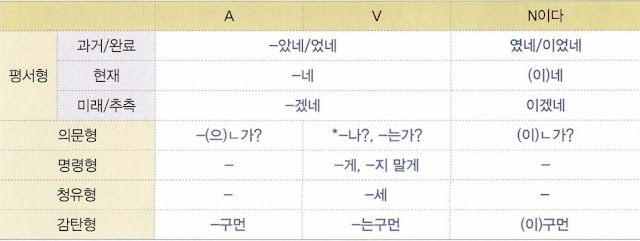가: 박 군. 오래간만이네. 어서 오게. 무슨 일인가?
Hey, Park. Long time no see. Come over here. What happened?
나: 교수님, 그동안 안녕하셨습니까? 다른 게 아니라 이번에 제가 졸업 논문을 쓰는데 조언을 얻고자 왔습니다.
Professor, how have you been? Actually, I came to get some help from you regarding my graduation thesis.
가: 벌써 자네가 졸업할 때가 됐나? 세월이 빠르구먼. 서서 그러지 말고 앉아서 차라도 마시면서 이야기하세.
Is it already time for you to graduate? My how time files. Have a seat, and we can talk over some tea or something.
나: 네, 감사합니다.
Yes, thank you.
This form of honorific is used when the speaker wants to speak in a slightly impolite way to the hearer either because the hearer is of a similar age or younger than the speaker or because they are on friendly terms with each other. Thus, it is used by professors toward their students, by bosses toward their employees (and by superiors toward those under them), and by mothers-in-law and fathers-in-law toward their sons-in-law, etc. In addition, it is also used among older individuals when they do not want to speak too impolitely.
 1. For declarative sentences, adjectives take the form -(으)이 while nouns take the form 일세.
1. For declarative sentences, adjectives take the form -(으)이 while nouns take the form 일세.
• 고마우이. 수고가 많으이.
Thank you. You’ve gone through a lot of effort.
• 참 오래간만일세. 여기가 내 방일세.
It’s been a really long time. This is my room.
2. In most cases, the pronoun ‘나’ is used to refer to the speaker himself/herself while ‘자네’ is used to refer to the other person.
• 나는 집에 가는 길이네. 자네는 어디에 가나?
I’m on my way home. Where are you going?
• 오랜만에 자네를 보니 반갑구먼.
I’m so happy to see you after such a long time.
3. When addressing the hearer, 이보게 or 여보게 is mainly used.
• 이보게, 이것 좀 도와주게.
Hey (you), help me out with this.
• 여보게, 같이 가세.
Hey (you), let’s go together.
>> Full of ‘Korean grammar in use – Intermediate’: Click here
>> Full of ‘Korean grammar in use – Advanced’: Click here
>> Follow my page to get Korean lessons: Say Hi Korean

